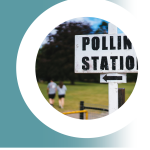
Dr Nick Anstead
Associate Professor at the Department of Media and Communications at the LSE. His research focuses on political communication and election campaigning. Nick is a Fellow of the Royal Society of the Arts, a frequent political commentator on national and international media.
Twitter: @nickanstead
Email: n.m.anstead@lse.ac.uk

UK Election 2024
Section 2: Voters, polls and results
13. Forecasting a multiparty majoritarian election with a volatile electorate (Dr Hannah Bunting)
14. The emerging infrastructure of public opinion (Dr Nick Anstead)
15. A moving target? Voter segmentation in the 2024 British General Election (Prof Rosie Campbell)
16. Don’t vote, it only encourages them? Turnout in the 2024 Election (Prof Charles Pattie)
17. Cartographic perspectives of the 2024 General Election (Prof Benjamin Hennig)
18. Gender and vote choice: early reflections (Dr Ceri Fowler)
19. Changing Pattern amongst Muslim voters: the Labour Party, Gaza and voter volatility (Dr Parveen Akhtar)
20. Religion and voting behaviour in the 2024 General Election (Dr Ekaterina Kolpinskaya, Dr Stuart Fox)
21. Failure to connect: the Conservative Party and young voters (Dr Stephanie Luke)
22. Youthquake for the progressive left: making sense of the collapse of youth support for the Conservatives (Prof James Sloam, Prof Matt Henn)
23. Values in the valence election (Prof Paula Surridge)
24. Tactical voting: why is it such a big part of British elections? (Thomas Lockwood)
It became a familiar refrain to say that opinion polling played too large a role in media coverage of the 2024 Election. Certainly, polling was central to much of the discussion during the campaign period.
This obsession with polling might seem surprising. After all, the overall result of the election and the likely winner was rarely in doubt. However, the clarity of the “Labour march to victory” narrative during the election campaign hides significant confusion in published polling numbers. Taking MRP polls as an example, the statistical range covered by the results suggested anything from a 1997-type result to a Labour victory on a scale not seen since the National Government in 1931 coupled with a Tory wipeout, which would have made the Liberal Democrats the official opposition. For some companies, the ultimate scale of the “miss” was comparable with the most infamous polling misfires, such as 1992 and 2015.
This vast range of predictions hints at a much more complex public opinion research landscape than in any previous election. The information being gathered and communicated to the public via the media is more diverse and complex than ever before.
The American political scientist Susan Herbst offers a useful theoretical device for understanding these changes, which she terms the public opinion infrastructure. Despite being a hugely discussed phrase in both popular discourse and academic research, public opinion tends to be an under-theorised concept, not least because its meaning is often assumed to be self-evident.
Herbst responds by historicising and breaking down the concept of public opinion. In a study of the 1930s, when the modern opinion polling industry developed in the United States, Herbst argues that we can understand public opinion as a combination of evolving measurement methods, the significance attributed to the output of those methods, and the way this significance is communicated more widely. In the 1930s, the technique developed by pollsters such as George Gallup was the representative sample opinion poll. The significance of the data generated was based on the claim to measure the electorate’s preferences accurately. Thus, polling enjoyed a level of democratic legitimacy. The communication of poll results was handled by mass media, who placed it at the centre of their political coverage (and paid for many of the polls).
The 2024 UK election may indicate the emergence of a new infrastructure with distinctive characteristics. These include:
Advanced statistical methods are used, distinct from traditional representative sample opinion polling. While not a new innovation, MRP (multi-level regression and post-stratification) polling was used at an unprecedented scale in 2024. This approach combines large sample polls with demographic data to predict the House of Commons post-election make-up.
Related to this is a much greater awareness of the institutional context in which the election is being fought, with a move away from just presenting national vote share figures and an increasing focus on seats won. Arguably, the defining feature in any modern UK election is the first-past-the-post election system and its consequences. The effects of the electoral system were magnified by politics which is increasingly multi-party in character, creating more challenges for pollsters.
While political parties have used qualitative methods, including focus groups, for decades, they are now increasingly used in political media coverage. These mediated focus groups often draw on demographics pollsters argue have particular electoral significance.
This leads to two related observations. First, we can defend public opinion research having a significant role in the campaign because it can potentially empower voters. For example, it may help them make the best use of their ballot in their constituency. But, related to that, if voters are going to be empowered by public opinion research, we need to develop new ways in which media coverage talks about that research, recognising the diversity and contradictions that exist and explaining that in a way voters can understand.
This was a tension very evident in political coverage in the 2024 Election. While it seems reasonable to suggest that contemporary public opinion research has become post-Gallupian in methods and scope, the language used to report public opinion data still draws heavily on the ideas and tropes from when the representative sample opinion poll was dominant, the Gallupian era. For example, MRP polls model the overall shape of the House of Commons by producing individual seat predictions. However, the margin of error for any particular seat can be huge, especially a seat with atypical features (such as an independent candidate standing). Often, though, this data was quoted uncritically and without appropriate caveats.
This mattered in an election marked by more parties winning more seats, more localised constituency campaigns, and higher levels of voter volatility. This pattern could well continue in future elections. In that sort of environment, voters need—and deserve—the best quality data explained in the clearest possible way.
